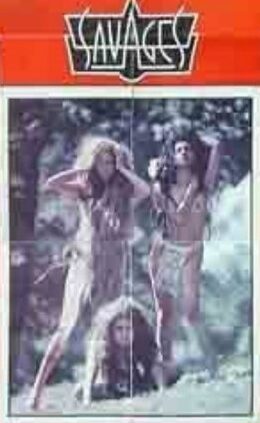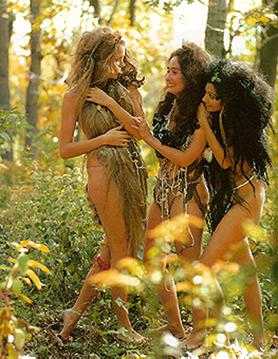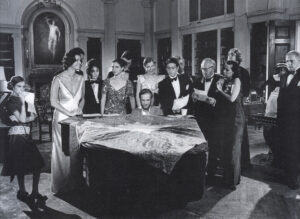 The very definition of a Cult Film: odd, esoteric and appreciated by only a select few. Its makers? None other than the deadly duo of producer Ismael Merchant (1936-2005) and director James Ivory, known for highbrow award-fodder like BOMBAY TALKIE, THE BOSTONIANS, HOWARD’S END and THE REMAINS OF THE DAY—films that, in the words of author Joe Queenan, tend to involve “doomed maharajas and women in crinoline with unbelievably stiff lips.”
The very definition of a Cult Film: odd, esoteric and appreciated by only a select few. Its makers? None other than the deadly duo of producer Ismael Merchant (1936-2005) and director James Ivory, known for highbrow award-fodder like BOMBAY TALKIE, THE BOSTONIANS, HOWARD’S END and THE REMAINS OF THE DAY—films that, in the words of author Joe Queenan, tend to involve “doomed maharajas and women in crinoline with unbelievably stiff lips.”
SAVAGES (1972), filmed on location in a “haunted house” in Scarborough, NY, is a bit of a departure from standard Merchant-Ivory fare (although it contains all the expected Anglo centric trappings). It certainly has the most varied and eclectic cast ever assembled for a Merchant-Ivory production, including Andy Warhol superstar Ultra Violet, the famed Indian Crooner Asha Puthli, future KARATE KID/CORBA KAI heavy Martin Kove, the TV starlets Susan (or, as she’s credited here, Susie) Blakely and Salome Jens, and the future Merchant-Ivory regular Sam Waterston.
In place of the duo’s favored screenwriter Ruth Prawer Jhabvala were NATIONAL LAMPOON’s then-editor Michael O’Donoghue (1940-1994) and his longtime confidante George W.S. Trow (1943-2006). It was Trow who apparently conceived the film together with James Ivory, as a reverse variant on Luis Bunuel’s THE EXTERMINATING ANGEL.
&n
Bunuel’s film, as you may recall, featured the denizens of an upscale dinner party descending into savagery upon finding themselves unable to leave the dining room. Conversely, as SAVAGES begins a prehistoric tribe of “savages” are seen roaming a vast forest, visualized via black-and-white photography and silent movie intertitles.
 A croquet ball rolls into the scene, leading the tribe to a deserted mansion. Inside this place the visuals turn sepia toned, and the savages make themselves at home. Cut to full color depictions of these well-groomed, immaculately attired characters behaving like refined gentlemen and women (or least trying to).
A croquet ball rolls into the scene, leading the tribe to a deserted mansion. Inside this place the visuals turn sepia toned, and the savages make themselves at home. Cut to full color depictions of these well-groomed, immaculately attired characters behaving like refined gentlemen and women (or least trying to).
As night falls these would-be aristocrats have a dinner party, where they analyze decayed fruit, debate the meaning of the term “bric-a-brac” and lip synch to 1920s pop tunes (actually specially written songs by O’Donoghue and Trow). But the veneer of civilization begins to slip after one of the group drowns himself in the swimming pool, followed by much miscellaneous sexual activity and another death: that of a young woman found hanging from a tree. The next morning sees the gang commencing a croquet match that devolves into an uncivilized free-for-all, with errant croquet balls leading them back into the forest.
SAVAGES was lensed in the fall of 1970, but wasn’t released until two years later, with box office takings that were as you’d expect. That was despite an editorial plug by O’Donoghue in the November 1972 issue of NATIONAL LAMPOON magazine, promising that “If RAW SEX, TWIN-FISTED ACTION and HIGH-VOLTAGE THRILLS are your cup of TNT, you won’t want to miss SAVAGES, a POWERHOUSE OF A MOVIE that BRISTLES WITH TENSION,” only to then admit that “Actually, SAVAGES is about as exciting as a six-pack of Carnation Instant Breakfast, but we thought maybe they could pull a few of these phrases for reviews.”
That last sentence is correct, as exciting is something this film isn’t. It’s downright dull, in fact, with an overarching tenuous-veneer-of-civilization metaphor that tends toward the glaringly obvious. There’s nothing resembling a sustained narrative, with characters defined entirely by the attributes assigned in the opening credits (such as Kove, who’s labelled “A Bully,” Blakely “A Debutante,” and Puthli “The Forest Girl”) and dialogue that’s relentlessly oblique.
The one and only thing the film has in its favor is an overpowering sense of fecund strangeness, bequeathed by the eerie sound design of the early scenes—in which distant animal chirping, chanting and indistinct narration (spoken in unsubtitled German and Hindi) are heard—and carried over into the later ones. For that reason the film is best experienced in restored DVD form, which presents the sound and atmospheric cinematography by Walter Lassally in their richest possible form. Be advised, though, that patience (a great deal of it!) is required.
Vital Statistics
SAVAGES
Angelika Films
Director: James Ivory
Producer: Ismail Merchant
Screenplay: George W.S. Trow, Michael O’Donoghue
Cinematography: Walter Lassally
Editing: Kent McKinney
Cast: Louis Stadlen, Anne Francine, Thayer David, Susie Blakely, Russ Thacker, Salome Jens, Margaret Brewster, Neil Fitzgerald, Eva Saleh, Ultra Violet, Asha Puthli, Martin Kove, Kathleen Widdoes, Christopher Pennock, Hester Leslie, Sam Waterston, Paulita Sedgwick

